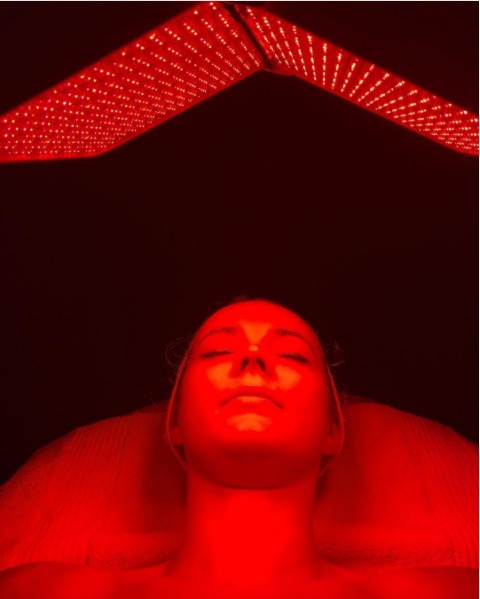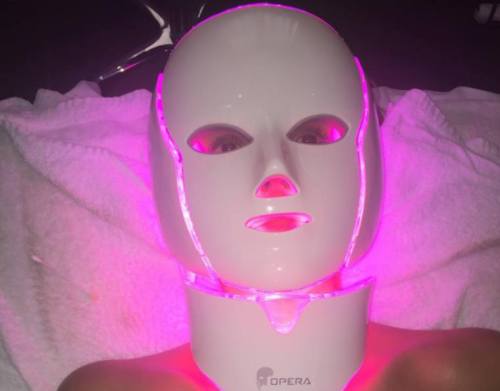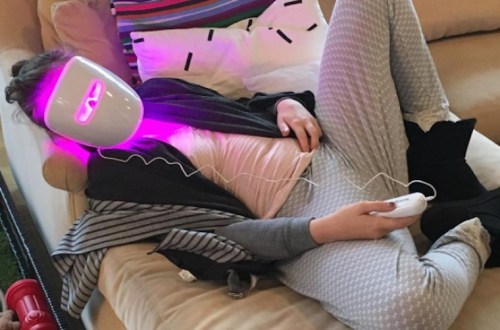If Emma Watson wasn’t already angling for the job, I’d definitely let Lena Dunham be my life coach: When the Girls star praised malasana squats for helping improve her dance moves, I listened. And when she posted a photo of herself on Instagram looking like she was auditioning for a part in the next Star Wars film from the comfort of her couch, I wanted to know more about the zany face mask with the neon glow she was rocking.
What I discovered was that, although my dreams of a Dunham/Driver reunion were still in a galaxy far, far away, the star’s LED accessory might just be the (much nearer) future of facial treatments.
Dunham’s face mask is a form of phototherapy, a treatment that’s able to help, ahem, shine a light on skin issues (like acne and aging) in a way topical treatments can’t right now. Because while great face oils and natural acne spot remedies can help with surface blemishes, they don’t always reach deep enough to penetrate the problem at its source. Behold the power of light!
Keep reading to get the lowdown on phototherapy’s light treatments.

So what exactly is phototherapy?
Phototherapy penetrates the skin on a cellular level by using LED light and works on two wavelengths: blue or red.
“Blue light therapy is great for acne and breakout conditions,” says Jeni Sykes, co-founder and head of skincare at New York City’s Heyday facial spa, which charges $35 for the add-on treatment. “It treats it by killing bacteria under the surface of the skin. The light calms inflammation, and, with those two things happening, you see breakouts being significantly clarified.”
Red LED light penetrates your dermis at its deepest level and is more for anti-aging benefits. “[It] reaches the bottom layers of the skin where the collagen and elastin structures live,” says Sykes. “Red light does two really vital things: It helps with the sun and other damagers that have broken or slowed our skin structures from regenerating themselves, and it stimulates your skin to start building new capillaries—which means new blood gets to the areas that show signs of aging. With [it] comes oxygen and the nutrients needed for your skin to heal and generate itself.”
Some multitasking light therapies, like Dunham’s mask, combine LEDs from both wavelengths, which is why they appear purple. All of them look pretty intense—which begs the question: Are LED treatments actually effective?
This Parisian Skincare Brand Is Launching in the United States for the First Time—Here’s What a Derm Wants You to Know

We’re Calling It: Cleansing Balms Are the Face Wash of the Future—Here Are 3 to Add to Your Cart

This Is the One Product That Scarlett Johansson Always Keeps in Her Purse and on Her Bedside Table


Does phototherapy actually work?
Light therapy is becoming buzzy on both social feeds and in facial salons, but it’s important to note that the treatment won’t work like magic with just one session—i.e. it’ll take more than one stormtrooper selfie a la Jessica Alba to see changes to your skin.
“It’s like a workout,” says Sykes. “You have to stick to it a few times before you really start to see results—they’re progressive and accumulative care.”
Sykes notes that phototherapy is really helpful for clients who have breakout conditions that are maybe a little more inflamed or don’t tolerate drying or traditional clarifying treatments very well. This includes people with hormonal breakouts and more sensitive skin.
She’s not the only one who has seen eye-opening results: Julie Zuckerman, a physician assistant at Schweiger Dermatology Group, “finds light therapy to be extremely effective—it really speeds up the process of getting acne under control.” She notes that consistency is the key to seeing long-term changes to your skin. “If you do it at least once a month, it can help to keep things controlled,” Zuckerman explains. “I generally think every two weeks, but it depends on if you’re treating or maintaining.” With the latter, every two months is all you need to see the light, so to speak.

Is phototherapy safe?
The treatment looks space age-y, and in some ways it is. Research groups in NASA started using light therapy, specifically for soft-tissue injuries, “long before [it found] its way into facial treatment rooms for everyday people,” says Sykes. “It’s non-toxic, completely non-invasive, and safe for pregnant or breastfeeding women.”
The real beauty of light therapy, though, is that it’s possible to add it to your skin regimen—whether at a facial salon, dermatologist’s office, or at home—without breaking the bank. The average cost of a professional phototherapy treatment is around $60, while brands like Neutrogena and Angel Kiss have launched at-home LED masks that cost $35 and $100, respectively.
No matter what you opt for, one thing’s clear: The future—and your skin—looks bright.
For other ways to get a healthy glow, here are 9 delicious smoothies to sip on for a clearer complexion. Or make like a pro and follow the 10 skin-care commandments facialists swear by.
Sign Up for Our Daily Newsletter
Get all the latest in wellness, trends, food, fitness, beauty, and more delivered right to your inbox.
Got it, you've been added to our email list.








